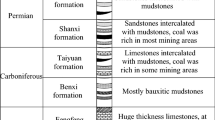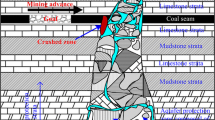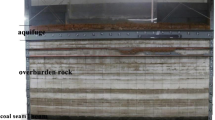Abstract
Quaternary unconsolidated porous aquifers are crucial to industrial, agricultural, and domestic water as well as ecological requirements in semiarid regions. Underground mining can influence aquifers even when they are located out of the fractured zone. Slight but continuous leakage should not be ignored. This study focused on the flow from a leaky aquifer. The deformation and fissure distribution characteristics and changes in the water resistance of a clay aquitard underlying an unconsolidated aquifer were studied by physical modeling, and the impacts on the unconsolidated aquifer were analyzed. Considering the mining-induced changes in the overburden hydraulic conductivity, we used numerical groundwater flow simulations of an unconsolidated aquifer to predict the flow dynamics of the aquifer for different scenarios. The influences of aquitard thickness and permeability on the groundwater flow regime of the regional unconsolidated aquifer under the mining area were quantitatively analyzed. This case study shows that the degree of coal extraction influence on the leaky confined aquifer depends on the properties of the aquitard beneath the aquifer. When the thickness was as high as 40 m and the hydraulic conductivity was as low as 10−6 cm/s, the aquitard could effectively prevent a water level depression. The results have practical implications for coal mining with water resource conservation.
抽象
第四系松散孔隙含水层对于半干旱区的工业用水、农业用水、生活用水以及生态需求至关重要。井工煤炭开采对导水裂隙带之上的含水层也会产生影响。轻微但持续的渗漏不可忽视。集中研究了越流含水层越流量。利用物理模拟,研究了松散含水层下粘性弱透水层的变形、裂隙分布和阻水能力变化,评价了它们对上覆松散含水层的影响。考虑采动引起的覆岩渗透系数的变化,采用数值模拟方法模拟松散含水层,预测不同情形下的水动力场特征。定量分析了开采条件下弱透水层厚度和渗透性对区域松散孔隙含水层地下水的影响。研究实例表明,采煤对越流含水层的影响程度取决于含水层下伏弱透水层的性质。当厚度达40 m,渗透系数低至10-6 cm/s时,弱透水层能有效地防止上覆含水层水位下降。研究结果对保水采煤具有实践指导意义。
Zusammenfassung
Quartäre unkonsolidierte Porenaquifere sind in semi-ariden Regionen für Industrie, Landwirtschaft, häusliche Wasserversorgung und ökologische Bedürfnisse äußerst wichtig. Untertagebergbau kann Aquifere auch dann beeinflussen, wenn diese über dem geklüftetem Fels liegen. Eine geringe aber stetige Sickerung darf nicht außer Acht bleiben. Diese Studie betrifft Abfluß aus einem lecken Aquifer. Deformation, Kluftverteilung und Veränderungen der Wasserresistenz eines tonigen Aquitards, welcher einen unkonsolidierten Aquifer unterlagert, wurden durch physikalische Modellierung untersucht. Die Auswirkungen auf den unkonsolidierten Aquifer wurden analysiert. Hinsichtlich bergbau-induzierter Veränderungen der hydraulischen Konduktivität des Deckgebirges benützten wir numerische Grundwasserflußsimulationen eines unkonsolidierten Aquifers um für verschiedene Szenarios die Fließdynamik des Aquifers vorher zu sagen. Quantitativ analysierten wir den Einfluß von Mächtigkeit und Durchlässigkeit des Aquitards auf das Grundwasserfließregime im Bergbaugebiet. Die Fallstudie zeigt, daß der Einflußgrad des Kohlenabbaues auf den leckenden gespannten Aquifer von den Eigenschaften des Aquitards unter dem Aquifer abhängt. Der Aquitard verhindert eine Absenkung des Wasserspiegels, wenn die Mächtigkeit 40 m und die hydraulische Konduktivität 10-6 cm/s beträgt. Es resultieren praktische Folgerungen für Kohlenbergbau mit Schutz von Wasserressourcen.
Resumen
Los acuíferos porosos no consolidados cuaternarios son cruciales para el agua industrial, agrícola y doméstica, así como para los requisitos ecológicos en las regiones semiáridas. La minería subterránea puede influir en los acuíferos incluso cuando se encuentran fuera de la zona fracturada. Las fugas leves pero continuas no deben ignorarse. Este estudio se centró en el flujo de un acuífero con fugas. Las características de deformación y distribución de fisuras y los cambios en la resistencia al agua de un acuitardo de arcilla subyacente a un acuífero no consolidado se estudiaron mediante modelado físico; se analizaron los impactos en el acuífero no consolidado. Teniendo en cuenta los cambios inducidos por la minería en la conductividad hidráulica de sobrecarga, utilizamos simulaciones numéricas de flujo de agua subterránea de un acuífero no consolidado para predecir la dinámica de flujo del acuífero para diferentes escenarios. Se analizaron cuantitativamente las influencias del espesor y la permeabilidad del acuitardo en el régimen de flujo de agua subterránea del acuífero regional no consolidado bajo el área minera. Este estudio de caso muestra que el grado de influencia de la extracción de carbón en el acuífero confinado con fugas depende de las propiedades del acuitardo debajo del acuífero. Cuando el grosor fue tan alto como 40 m y la conductividad hidráulica tan baja como 10-6 cm/s, el acuitardo podía prevenir efectivamente una depresión del nivel del agua. Los resultados tienen implicaciones prácticas para la minería del carbón con conservación de los recursos hídricos.










Similar content being viewed by others
References
Ben-Itzhak LL, Gvirtzman H (2005) Groundwater flow along and across structural folding: an example from the Judean Desert, Israel. J Hydrol (Amsterdam) 312(1–4):51–69
Bian Z, Miao X, Lei S, Chen S, Wang W, Struthers S (2012) The challenges of reusing mining and mineral-processing wastes. Science 337(6095):702–703
Booth CJ (2006) Groundwater as an environmental constraint of longwall coal mining. Environ Geol 49(6):796–803
Brandyk A, Majewski G, Kiczko A, Boczoń A, Wróbel M, Porretta-Tomaszewska P (2016) Ground water modelling for the restoration of Carex communities on a sandy river terrace. Sustainability 8(12):1324
Du F, Gao R (2017) Development patterns of fractured water-conducting zones in longwall mining of thick coal seams—a case study on safe mining under the Zhuozhang River. Energies 10(11):1856
Fan G, Zhang D (2015) Mechanisms of aquifer protection in underground coal mining. Mine Water Environ 34(1):95–104
Hill JG, Price DR (1983) The impact of deep mining on an overlying aquifer in western Pennsylvania. Groundwater Monit Remediat 3:138–143
Huang Q (2014) Research on cracks zone of clay aquiclude in overburden. Appl Mech Mater 548–549:1744–1747
Izady A, Abdalla O, Joodavi A, Chen M (2017) Groundwater modeling and sustainability of a transboundary hardrock–alluvium aquifer in North Oman Mountains. Water 9(3):161
Kallioras A, Pliakas F, Diamantis I (2010) Simulation of groundwater flow in a sedimentary aquifer system subjected to overexploitation. Water Air Soil Pollut 211(1–4):177–201
Karacan CÖ, Goodman G (2009) Hydraulic conductivity changes and influencing factors in longwall overburden determined by slug tests in gob gas ventholes. Int J Rock Mech Min Sci 46(7):1162–1174
Kloosterman FH, Stuurman RJ, Meijden RVD (1995) Groundwater flow systems analysis on a regional and nation-wide scale in the Netherlands: the use of flow systems analysis in wetland management. Water Sci Technol 31(8):375–378
La Licata I, Colombo L, Francani V, Alberti L (2018) Hydrogeological study of the glacial—fluvioglacial territory of Grandate (Como, Italy) and stochastical modeling of groundwater rising. Appl Sci 8(9):1456
Liu J, Elsworth D, Matetic RJ (1997) Evaluation of the post-mining groundwater regime following longwall mining. Hydrol Process 11(15):1945–1961
Ma L, Jin Z, Liang J, Sun H, Zhang D, Li P (2015) Simulation of water resource loss in short-distance coal seams disturbed by repeated mining. Environ Earth Sci 74(7):5653–5662
Martin PJ, Frind EG (1998) Modeling a complex multi-aquifer system: the Waterloo moraine. Groundwater 36(4):679–690
Miao X, Cui X, Wang J, Xu J (2011) The height of fractured water-conducting zone in undermined rock strata. Eng Geol 120(1–4):32–39
Mohammadzadeh H, Dadgar MA, Nassery H (2017) Prediction of the effect of water supplying from Shirindare dam on the Bojnourd aquifer using Modflow 2000. Water Resour 44(2):216–225
Newman C, Agioutantis Z, Leon GBJ (2017) Assessment of potential impacts to surface and subsurface water bodies due to longwall mining. Int J Min Sci Tech 27(1):57–64
Peng SS (1992) Surface subsidence engineering. Soc for Mining, Metallurgy and Exploration, New York City
Qiu S, Liang X, Xiao C, Huang H, Fang Z, Lv F (2015) Numerical simulation of groundwater flow in a river valley basin in Jilin urban area, China. Water 7(10):5768–5787
Scanlon BR, Keese KE, Flint AL, Flint LE, Gaye CB, Michael Edmunds W, Simmers Ian (2010) Global synthesis of groundwater recharge in semiarid and arid regions. Hydrol Process 20(15):3335–3370
Singh MM, Kendorski FS (1981) Strata disturbance prediction for mining beneath surface water and waste impoundments. In: Proc, 1st conf on ground control in mining, West Virginia Univ, Morgantown
Sun W, Wu Q, Liu H, Jiao J (2015) Prediction and assessment of the disturbances of the coal mining in Kailuan to karst groundwater system. Phys Chem Earth Parts A/B/C 89–90:136–144
Tammetta P (2015) Estimation of the change in hydraulic conductivity above mined longwall panels. Groundwater 53(1):122–129
Tok GC, Il JK (2018) Method of simulation and estimation of SCW system considering hydrogeological conditions of aquifer. Energy Build 163(15):140–148
Wang M, Li J (1987) Technology of mine water control in China. Mine Water Environ 6(3):25–38
Xie P, Li W, Yang D, Jiao J (2018) Hydrogeological model for groundwater prediction in the Shennan mining area, China. Mine Water Environ 37(3):505–517
Xu S, Zhang Y, Shi H, Wang K, Geng Y, Chen J (2018) Physical simulation of strata failure and its impact on overlying unconsolidated aquifer at various mining depths. Water 10(5):650
Yang Y, Kalin R, Zhang Y, Lin X, Zou L (2001) Multi-objective optimization for sustainable groundwater resource management in a semiarid catchment. Hydrol Sci J 46(1):55–72
Yuan H, Zhang G, Yang G (2009) Numerical simulation of dewatering thick unconsolidated aquifers for safety of underground coal mining. Int J Min Sci Technol 19(3):312–316
Zeng Y, Wu Q, Liu S, Zhai Y, Lian H, Zhang W (2018) Evaluation of a coal seam roof water inrush: case study in the Wangjialing coal mine, China. Mine Water Environ 37(1):174–184
Zhang D, Fan G, Ma L, Wang X (2011) Aquifer protection during longwall mining of shallow coal seams: a case study in the Shendong Coalfield of China. Int J Coal Geol 86(2–3):190–196
Zhang S, Tang S, Zhang D, Fan G, Wang Z (2017) Determination of the height of the water-conducting fractured zone in difficult geological structures: a case study in Zhao Gu no. 1 coal seam. Sustainability 9(7):1077
Zhang Y, Xu Y, Wang K, Chen P, Wang X, Zheng Q, Zhang Z (2018) The fracturing characteristics of rock mass of coal mining and its effect on overlying unconsolidated aquifer in Shanxi, China. Arab J Geosci 11:666
Acknowledgements
This research was funded by the National Natural Science Foundation of China, Grant 41572221; Research Fund of Key Research Program of Ministry of Science and Technology for Water Resources Efficient Development and Utilization Project [2018YFC0406403]; and the National Natural Youth Science Foundation of China, grant 41502243. We gratefully acknowledge the financial support and thank Engineers Haodong Sun and Xue Wang and Assistant researcher Jun Zhu for aiding in conducting this research. We also thank the editors and peer reviewers for their time, careful work, and helpful suggestions.
Author information
Authors and Affiliations
Corresponding author
Electronic supplementary material
Below is the link to the electronic supplementary material.
10230_2019_649_MOESM2_ESM.pdf
Supplementary material 2 Supplemental Figure S-2 Groundwater level fitting curves (a) Calibration period (b) Validation period (c) The fitting of the water level duration curves for typical observation wells (PDF 110 kb)
Rights and permissions
About this article
Cite this article
Xu, S., Zhang, Y., Shi, H. et al. Impacts of Aquitard Properties on an Overlying Unconsolidated Aquifer in a Mining Area of the Loess Plateau: Case Study of the Changcun Colliery, Shanxi. Mine Water Environ 39, 121–134 (2020). https://doi.org/10.1007/s10230-019-00649-7
Received:
Accepted:
Published:
Issue Date:
DOI: https://doi.org/10.1007/s10230-019-00649-7




